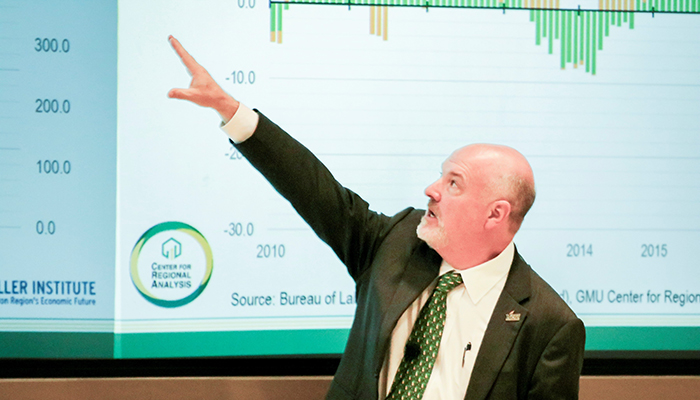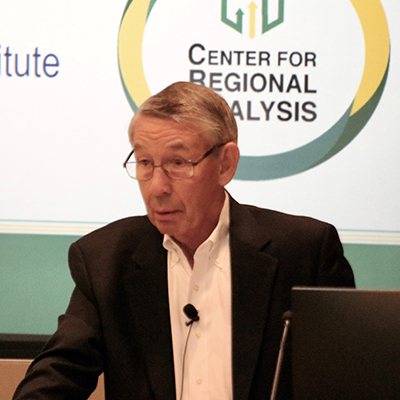In This Story


After a three-year in-person hiatus, the highly anticipated annual Stephen S. Fuller Institute Economic Forum resumed at George Mason University’s Mason Square. The event brings together business leaders and decision makers from around the Washington, D.C., region to hear economic scientists reveal what (might) be in the immediate future for the economy and to apply that information to their own fates as they see fit.
Only this time, on November 15, the meeting was the debut event of the CRA/Fuller Institute Joint Economic Outlook Forum, the first summit presented by the newly combined Center for Regional Analysis (CRA) and the Stephen S. Fuller Institute for Research on the Washington Regin’s Economic Future (SFI). Both are housed at the Schar School of Policy and Government, with the SFI now a subunit of the CRA. (See Two George Mason University Economic Forecasting Powerhouses Join Forces.)
Eighty-plus curious and engaged audience members attended the Tuesday morning briefing. Following a welcome by Schar School dean Mark J. Rozell, Mason president Gregory Washington reminded the audience of the CRA and SFI’s historic roles in preparing the region’s leaders to navigate the coming economic challenges by providing dependable and candid forecasts.
Washington was followed by longtime business leader Robert E. Buchanan, a third-generation builder and developer who has long advocated for cooperation among all the region’s economic sectors to create success throughout the economy. This time his bridge-building plea was more impassioned than usual as he called on leaders to foster acceptable partnerships, even among competitors, in order to get past the economic damage wrought by the pandemic.
Stephen S. Fuller took the stage for the first time in three years. The now-retired professor, who joined the CRA in 1994, presented a historic perspective on the economy, calling on complex data to tell the story of how we arrived to where we are and teeing up the discussion for the presentation by Terry Clower, a professor of public policy and the director of the combined CRA and SFI, who had the far riskier mission of demonstrating where the economy (may) be going in the near and distant future.
Bottom line? Bottom line? Washington is not the “recession-proof” economy it was once thought to be.
“While the regional economy will not see a substantial downturn during the national recession that is likely to hit in 2023, we have several challenges that are inhibiting economic competitiveness,” Clower said following the forum. The Washington, D.C., metro area has been trailing all major U.S. markets in job growth. Housing costs, talent attraction and retention, workforce development, and our innovation and entrepreneurial eco-systems are among the key issues that need attention if we are to regain our competitive edge.
“We have the ability to address all of these issues, but we have to do so through collaborations that cross jurisdictional boundaries and by creating and sustaining partnerships between local governments, businesses, and the non-profit sector,” said Clower.
The combined resources of CRA and SFI are “poised to play a key role in providing data and analysis to regional leaders in support of the combined efforts to create a vibrant, growing economy that offers opportunity for all or our residents.”
